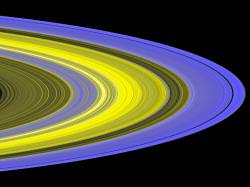New observations from NASA’s Cassini spacecraft have revealed that Saturn’s largest ring isn’t a smooth distribution of particles like it looks in photographs. Instead, it’s actually made up of tightly packed clumps of material surrounded by empty spaces.
According to researchers, these clumps of material are constantly colliding, breaking up, and reforming. And these clumps have hidden the mass of Saturn’s rings. Scientists originally estimated the mass of Saturn’s rings, assuming that particles were evenly distributed. But taking these clumps into account, the rings could be two or more times previous estimates.
To make the calculation, astronomers measured the brightness of a stars as they passed behind the rings. This allowed Cassini to measure the amount of material obscuring the stars, and so scientists could determine the thickness of the rings. Instead of fading gradually, the stars flickered in brightness as they passed behind these clumps.
These observations confirm that theory that the particles in Saturn’s rings gravitationally attract one another, bunching up into “self-gravity wakes”. If they were further from Saturn, the clumps would eventually form moons. But Saturn’s gravity tears them apart, halting their growth when they get larger than 30 to 50 meters (about 100 to 160 feet) across.
Original source: NASA/JPL/University of Colorado News Release

